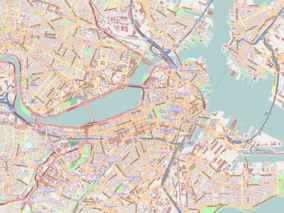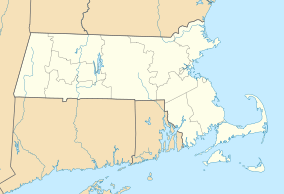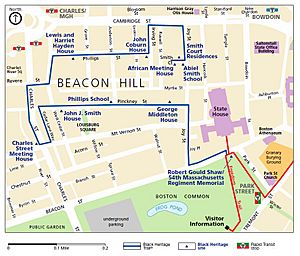Boston African American National Historic Site facts for kids
Quick facts for kids Boston African AmericanNational Historic Site |
|
|---|---|
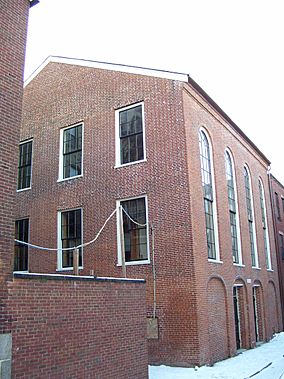
The African Meeting House in Boston, built by African Americans in 1806
|
|
| Location | Boston, Massachusetts, United States |
| Nearest city | Boston, Massachusetts |
| Area | 0.18 acres (0.073 ha) |
| Established | October 10, 1980 |
| Visitors | 327,921 (in 2011) |
| Governing body | National Park Service |
| Website | Boston African American National Historic Site |
The Boston African American National Historic Site is a special place in Boston, Massachusetts. It's located in the Beacon Hill neighborhood. This site helps us learn about the history of Boston's African-American community in the 1800s.
It includes 15 buildings from before the American Civil War. These buildings are connected by a path called the Black Heritage Trail. One important building is the African Meeting House, built in 1806. It is the oldest standing black church in the United States.
Contents
Discovering Boston's Black History
This historic site is on Beacon Hill, a neighborhood near Boston Common. It was created in 1980 to save and remember the original buildings. These buildings were home to the free African-American community on Beacon Hill in the 1800s.
In 1980, President Jimmy Carter signed bills to create this site. He also approved the Martin Luther King, Jr. National Historic Site. He said these efforts would help preserve a "long neglected" part of American history. This history includes the culture of Americans of African ancestry.
Early African Americans in Boston
The first African residents came to Boston as slaves in 1638. Over time, more people were born free. Some slaveholders also freed their slaves. After the American Revolutionary War, Massachusetts ended slavery. By 1790, there were no slaves recorded in Massachusetts.
A large community of free Black people and escaped slaves grew in Boston. They settled on Beacon Hill and in the North End. Boston was a safe place for slaves escaping from the South. Many came through the Underground Railroad. African Americans in Boston became leaders in the abolition movement. This movement worked to end slavery. They also fought for racial equality and equal education.
Before the American Civil War, more than half of Boston's 2,000 African Americans lived on Beacon Hill. Other Black residents lived in the West End and the North End. Later, new groups of immigrants moved into these areas. African Americans then moved to other parts of Boston.
This historic site is one of 39 African-American Heritage Sites managed by the National Park Service.
Walking the Black Heritage Trail
The National Park Service explains that the buildings on the Black Heritage Trail were important. They were homes, businesses, schools, and churches. A strong Black community lived here. They worked together to fight against unfair treatment and slavery. They wanted the equality and freedom promised in America's founding documents.
The Black Heritage Trail is about 1.6 miles (2.5 km) long. It winds through Beacon Hill. Here are some of the important places you can see:
- Robert Gould Shaw / 54th Massachusetts Volunteer Regiment Memorial – This monument honors the first African-American regiment in the United States Colored Troops. They fought in the American Civil War. It shows their march down Beacon Street. The regiment's brave fight at Fort Wagner was shown in the movie Glory.
- African Meeting House – Built in 1806, this is the oldest standing African-American church in the country. It's now part of the Museum of African American History. It was known as the Black Faneuil Hall during the abolitionist movement. Famous speakers like Frederick Douglass gave speeches here.
- Abiel Smith School – Built in 1834, this was one of the first schools for Black children. It is now also part of the Museum of African American History.
- Charles Street Meeting House – This church, built in 1807, used to have separate seating for Black and white members. In the 1830s, some members formed a new church that was one of America's first integrated churches.
- John Coburn House – This was the home of John Coburn. He was an African-American abolitionist and soldier. He helped people escape slavery on the Underground Railroad.
- Lewis and Harriet Hayden House – Lewis Hayden was an escaped slave and a leader in the abolitionist movement. He helped recruit soldiers for the 54th regiment. He also protected escaped slaves in his home.
- George Middleton House – This is one of the oldest homes on Beacon Hill. George Middleton led a Black militia called the Bucks of America during the American Revolutionary War.
- Phillips School – This was one of Boston's first schools that allowed both Black and white students.
- Smith Court Residences – These five homes show what Black Bostonians' houses looked like in the 1800s. William Cooper Nell, an author and early Black historian, lived at 3 Smith Court.
- John J. Smith House – John J. Smith was an abolitionist leader. He helped runaway slaves and recruited soldiers for the Civil War. He later served in the Massachusetts House of Representatives.
Most of these places are still private homes today. However, you can visit the African Meeting House, the Abiel Smith School, and the 54th Regiment Memorial.
Park rangers offer free guided tours of the trail in the summer. You can also get a map for a self-guided tour online or at the historic site.
Learning Programs and Events
The staff at the site worked on a program called Freedom Rising in 2013. This event celebrated the 150th anniversary of the Emancipation Proclamation. It also honored African American soldiers in the Civil War. Famous people like historian Henry Louis Gates and actor Danny Glover took part.
Important Moments in Black Boston (1638–1909)
| Year | Image | Event |
|---|---|---|
| 1638 | The first enslaved Africans arrived in Boston. | |
| 1641 | Massachusetts made laws that allowed slavery in the colony. | |
| 1770 | 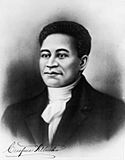 |
Crispus Attucks, an escaped slave, was the first person killed in the Boston Massacre. He became a symbol of Black men fighting for freedom. |
| 1783 | Slavery ended in Massachusetts. The state declared it was against its constitution. | |
| 1790 | Massachusetts was the only state in the U.S. with no slaves recorded in the first census. | |
| 1798 | The first private school for Black children opened in Primus Hall's home. | |
| 1800 | The free Black population in Boston grew to almost 1,100 people. | |
| 1806 | 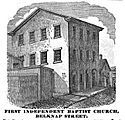 |
The African Meeting House opened as the First African Baptist Church. It was a place for church, school, community groups, and anti-slavery meetings. |
| 1826 |  |
The Massachusetts General Colored Association, a Black group against slavery, was founded. They worked against unfair treatment and slavery. |
| 1829 | 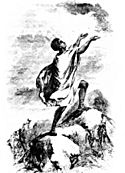 |
David Walker published The Appeal. This essay urged enslaved people to fight for their freedom. |
| 1831 |  |
William Lloyd Garrison started publishing The Liberator (anti-slavery newspaper). This newspaper supported alliances between Black and white people against slavery. |
| 1832 | 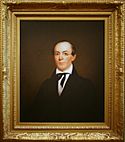 |
Garrison formed the New England Anti-Slavery Society at the African Meeting House. |
| 1835 | The Abiel Smith School, the first school just for Black children, opened. | |
| 1850 | 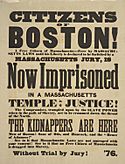 |
The Fugitive Slave Act was passed. This law said that even free states had to return escaped slaves to their owners. Many people in Boston protested this law. |
| 1855 | 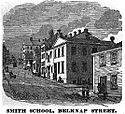 |
Boston's public schools became integrated, meaning Black and white students could attend together. The Abiel Smith School then closed. |
| 1861 |  |
The American Civil War began. |
| 1863 |  |
The Emancipation Proclamation was signed. This document freed many enslaved people. The 54th Regiment Massachusetts Volunteer Infantry was formed. It was the first all-Black regiment from the North. They fought bravely at Fort Wagner. |
| 1865 |  |
The Civil War ended. The 13th Amendment officially ended slavery. Many freed African Americans moved North, including to Boston. |
| 1897 | 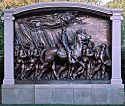 |
The Robert Gould Shaw Memorial was dedicated on Boston Common. It honored the 54th Massachusetts Regiment. |
| 1900 | Sgt. William H. Carney received the Medal of Honor. He was the first Black person to receive this award. | |
| 1909 | The National Association for the Advancement of Colored People (NAACP) was founded. Many people in Boston joined this group. |
African American Population in Boston
| Year | Number | Percent of population |
|---|---|---|
| 1820 |
1,690
|
3.90
|
| 1830 |
1,875
|
3.05
|
| 1840 |
2,427
|
2.60
|
| 1850 |
1,999
|
1.46
|
| 1860 |
2,261
|
1.27
|
| 1870 |
3,496
|
1.40
|
| 1880 |
5,873
|
1.62
|
| 1890 |
8,125
|
1.81
|
The number of African Americans in Boston grew a lot during the 1800s. However, many new immigrants from Europe also moved to Boston during this time. These immigrants came from places like Ireland, Italy, and Eastern Europe.
See Also


